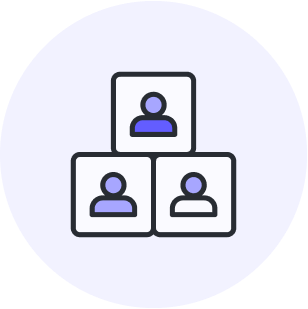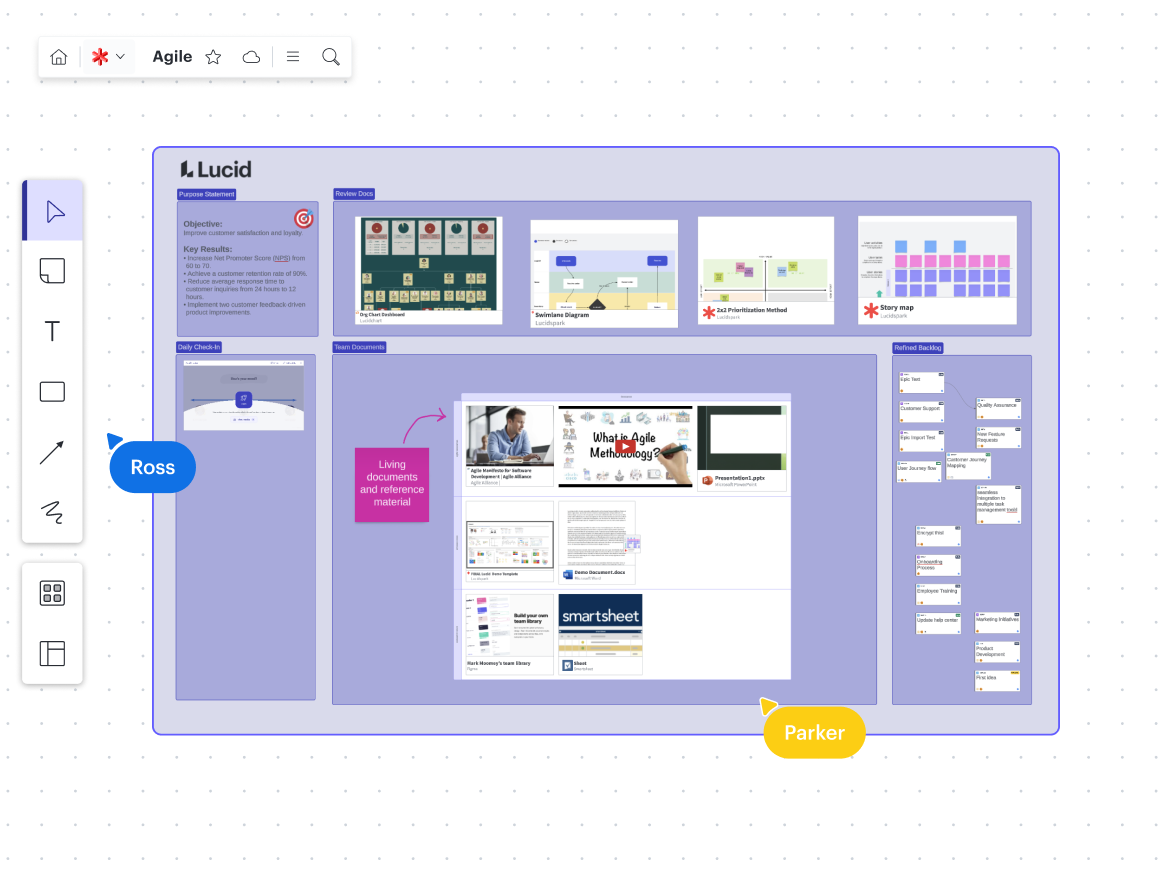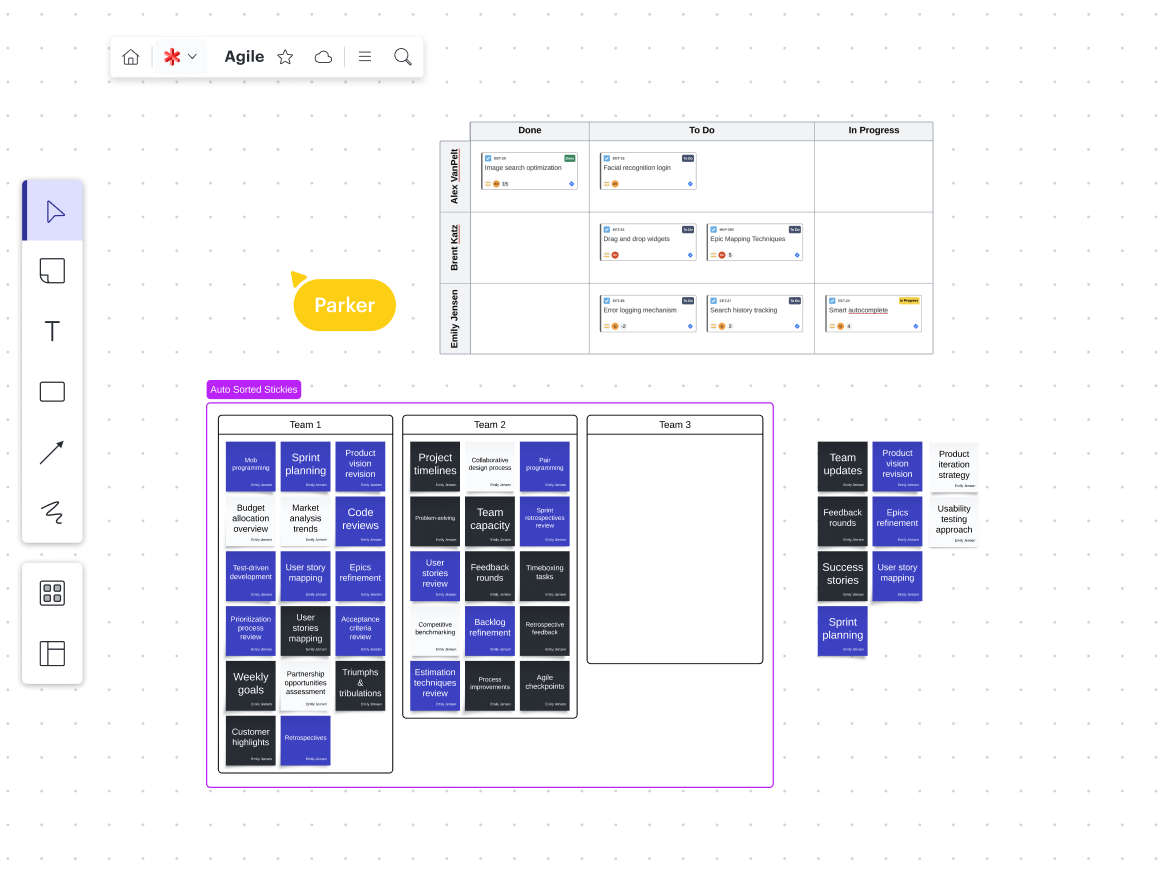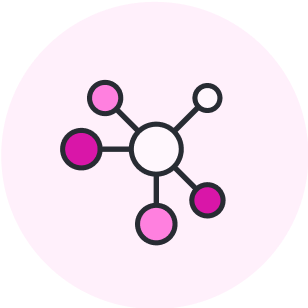
How to sustain the Agile Manifesto values in today’s workforce
Reading time: about 11 min
Topics:
Today’s workforce has become increasingly hybrid, introducing a new set of challenges when it comes to working in Agile. As work models shift and people’s needs change, how can teams continue to sustain the values of Agile—no matter where they work from?
Lucid’s resident Agile experts—Jessica Guistolise, evangelist, and Bryan Stallings, chief evangelist—shared tactical tips to answer this question and show teams how to stay Agile in today’s workforce. Guistolise and Stallings have over 30 years of combined experience coaching individuals and teams in Agile techniques.
What are the four values of the Agile Manifesto?
The Agile Manifesto was created in 2001 by 17 software practitioners who saw the need for an alternative approach to traditional software development processes.
The result was a philosophical document outlining four key values:
- Individuals and interactions over processes and tools
- Working software over comprehensive documentation
- Customer collaboration over contract negotiation
- Responding to change over following a plan
“The manifesto was written in reaction to the ways of working at that time, when the opposite (valuing what is on the right) was the norm for each of these value statements,” explains Stallings.
The values on the right remain important, but the Agile mindset prioritizes the values on the left. However, the shift to remote and hybrid work in recent years has impacted the balance of these values and introduced new challenges for implementing Agile at work.

A hybrid team’s toolkit for Agile meetings
Get templates and tips to make your Agile events—from sprint planning to retrospectives—successful in a hybrid environment.
Get the toolkitTeams face new challenges with the shift to remote and hybrid work
As of 2023, 80% of employees work either fully remote or hybrid (part of the week at home and part in the office). This data represents a massive shift in how, where, and when we work. As a result, it’s been a challenge for many teams to successfully align with these Agile values.
For example, with individual team members working in different places and during different time zones, it’s difficult to communicate effectively and keep processes consistent across the team. It also means decisions are often being made asynchronously instead of together in a team meeting or over real-time messaging like in the past, making it harder to stay aligned.
Additionally, documentation has become more important with the rise of async work as it serves as one of the primary ways teams can stay aligned. This shift has also resulted in a greater reliance on tools for interacting, collaborating, and maintaining visibility into work.
The challenge, then, is: How do we continue to lean on individuals and interactions and use the processes and tools in ways that will help?
“We can honor the values of the Agile manifesto and create high-performing team experiences,” Stallings assures. Keep reading (or watch the webinar recording below) to learn how.
Tips for sustaining each of the values of the Agile Manifesto
“People are what make Agile so effective,” says Guistolise. “And people need certain things in place in order for their teams to be effective and to work on these complicated, interesting problems that we’re all trying to solve.”
These include:
- Communication
- Transparency
- Alignment
- Flexibility
Let’s dive into how to best enable the individuals on Agile teams to succeed in hybrid and remote environments.
Individuals and interactions over processes and tools
The Agile Manifesto calls for collaborative work where team members come together to communicate directly, make decisions collaboratively, and reduce reliance on tools and processes.
This used to mean meeting face-to-face in the same room to hash everything out. Now, because most teams no longer work in the same place, we need tools and techniques to support these same interactions.
Here are our recommendations for sustaining this value:
Have an open Zoom meeting
Sometimes, recreating face-to-face interactions is as simple as jumping on a video call. “For example, Bryan and I work together every day, and we set up an extended Zoom meeting so we can work together as if we were sitting side by side. Or, we can work on separate items but easily ask for help or feedback at any moment, mimicking walking over to someone’s desk,” Guistolise explains.
For coworkers with overlapping time zones and schedules, just having an open video call in the background can bridge that communication gap created by hybrid and distributed office arrangements.
Establish a virtual “where”
“Much has changed in the way we work today,” Stallings says. “But some things haven’t.”
“For example, we still have our Agile teams. That’s our who. That hasn’t changed. We still have our objectives and a vision that we’re pursuing. That’s our what and our why. We still have our sprint cadence. That’s our when. But for most of us, the thing we no longer have in common is our where.”
—Bryan Stallings, chief evangelist, Lucid
Hybrid and remote teams still need a shared place to meet, create, and collaborate. They need a virtual “where.”
“This should be a common digital environment—a place where every team member can come together to communicate and collaborate visually,” Stallings explains. This space needs to allow team members to document and create, whether they’re there at the same time or collaborating asynchronously.
To establish a virtual “where,” you can use Lucid’s team spaces, a place for teams to coordinate and initiate work.
Team spaces in Lucid helps Agile teams establish their virtual “where” by:
- Providing transparency into work and helping teams coordinate progress.
- Enabling both real-time and asynchronous collaboration.
- Giving team members a place to consistently return to for connection and knowledge-sharing.

Team spaces brings together all relevant documentation—from both the Lucid Suite and outside platforms—so all of your files can live in this shared space for everyone to access and see.
Features such as comments, tagging, emojis, and more keep teams connected and give everyone a voice in the conversation. It’s also a great way to establish a team dynamic without needing everyone to be in the same physical location.

Get more tips on how to prioritize individuals and interactions in a hybrid environment.
Check it outWorking software over comprehensive documentation
There is little value in creating, maintaining, and reviewing a long specifications doc vs. incrementally demonstrating that the software is functional. With Agile, the only real measure of progress is running, tested features.
“However, these values and principles don’t mean ‘no documentation,’” Stallings says. “Rather, the documentation we create should support getting to working software and should add value to the people who consume the document.”
Here’s how we recommend upholding this value:
Document as you go
While Agile teams may avoid most formal docs that have only transitory value (think formalized UML documents vs. sketches), they should prioritize and create documentation that has persistent value. For example, this might be docs for end users, docs for operations, docs for compliance, or technical design docs that allow teams to track where they’ve come from and the paths and decisions taken to arrive where they are.
And this is what Agile teams love about Lucid: By collaborating visually in Lucid—sketching diagrams, brainstorming, creating roadmaps, and more—you naturally create a living blueprint of the business.
“As we work in tools like Lucidchart and Lucidspark, we’re creating that history as we go,” Stallings explains. “We’re creating a record of what we’ve done, the decisions we’ve made, and the things we tried.”
For example, instead of having to formally document a brainstorm or the actions that come from it, when we brainstorm collaboratively in Lucid, that documentation is already right there, visible, and easy for team members to reference at any time.
It’s also highly efficient to work in a way that yields a record of our work. Just think:
-
Individuals no longer have separate notes or different understandings or takeaways from the meeting.
-
Documentation is visible to all as we collaborate, simplifying the work to make sense of the information.
-
A shared whiteboard is a collaboratively generated document that requires no extra time or effort and allows us to focus on real value.
As a result, Lucid helps teams build alignment, save time, and avoid over-documentation—all while creating a living blueprint of the business that is easy to share, access, and update over time.

Agile Manifesto co-author James Grenning shares his thoughts on the importance of documentation for Agile teams.
Read the interviewCustomer collaboration over contract negotiation
With Agile, we know that we will learn along the way, unexpected requirements will emerge, and we'll need to change–often in unpredictable ways. This mindset means we will also need to collaborate with customers and stakeholders as the project evolves.
Luckily, there are still powerful ways for Agile teams to maintain collaborative environments even when they are working from different time zones or locations. Here’s how:
Co-create with your customer
Bring the customer into your collaborative environment (like Lucid) to capture their ideas, show them the roadmap, or discuss backlog items. You might even create a bespoke room or space within Lucid specifically for your collaborative interactions with the customer.
This technique allows for a high amount of customer interaction and quality feedback that results in faster turnaround, increased clarity, and fewer gaps in our understanding that lead to friction or sparring over contract details.
Use visuals to ensure alignment
Phone calls and even video calls are not ideal for bridging gaps in understanding and mapping out plans, priorities, and responsibilities when working with your customers. Visuals, on the other hand, help teams and customers reach a shared understanding significantly faster.
Agile teams can use Lucid to capture customer feedback in context. Teams can even invite customers as guest collaborators on Lucid boards so they can interact and communicate directly.
Features like Visual Activities and voting can also be used with customers (not just internal teams), allowing you to easily poll stakeholders and learn what your customers want.

Responding to change over following a plan
Before Agile, project management was all about creating and following a detailed plan. Under this model, change was impossible–with some plans built out for nine months to over a year.
Now, with Agile, we work in a way that allows for uncertainty and learning. �“We have to allow change to emerge,” says Guistolise. “And to respond to the change, we also have to be able to see the change and easily pivot—all while keeping everyone on the same page.”
How can we embrace change and respond cohesively in today’s hybrid workforce? Here’s our top tips:
Make your plans visible—and share these visuals to create alignment
We’ve talked about the power of visuals and their ability to build alignment on meaning and increase clarity around changing targets. Visualizing your plans makes it much easier to see the big picture and how each piece fits together, especially as those components change or evolve over the lifetime of the project.
For example, when you visualize your plans in Lucid, you can easily share those documents with outside stakeholders so they can see updates to your plans in real time. Lucid offers a variety of sharing options including direct links to the docs, converting your boards to PDFs, or even embedding the board in a wiki. Wherever your team and customers are, you can share Lucid at the click of a button.

Visualize dependencies to mitigate risk
Visualizing dependencies is an important aspect of responding to change. Dependency mapping helps teams identify potential bottlenecks or delays ahead of time and mitigate risk. Using a dependency map can increase clarity and alignment that's needed for successful cross-functional collaboration.
You can use Lucid to visualize dependency data in real time directly from Jira and Azure DevOps. Then, you can see how dependencies fit within your larger workflow.
As you make changes to your visuals, the magic of Lucid ensures they are updated in places where you’ve linked or published the information. This automation allows teams to respond and pivot quickly in Lucid rather than polishing documentation in Jira, Azure DevOps, Google Docs, PowerPoint, or other static sources.
Empower your Agile teams with Lucid
As today’s teams work in increasingly hybrid and distributed arrangements, sustaining Agile values requires equipping teams with the right tools for the job. And when it comes to working in an Agile environment, Lucid is a natural fit.
Lucid’s flexible, visual platform enables teams to communicate, collaborate, and document their work as they go—anytime, anywhere. Keep customers in the loop from day one with visual brainstorming, planning, and activities that build alignment and trust. Map projects visually from the start to more easily identify roadblocks, uncover opportunities, and adjust as needed.

About Lucid
Lucid Software is the leader in visual collaboration and work acceleration, helping teams see and build the future by turning ideas into reality. Its products include the Lucid Visual Collaboration Suite (Lucidchart and Lucidspark) and airfocus. The Lucid Visual Collaboration Suite, combined with powerful accelerators for business agility, cloud, and process transformation, empowers organizations to streamline work, foster alignment, and drive business transformation at scale. airfocus, an AI-powered product management and roadmapping platform, extends these capabilities by helping teams prioritize work, define product strategy, and align execution with business goals. The most used work acceleration platform by the Fortune 500, Lucid's solutions are trusted by more than 100 million users across enterprises worldwide, including Google, GE, and NBC Universal. Lucid partners with leaders such as Google, Atlassian, and Microsoft, and has received numerous awards for its products, growth, and workplace culture.
Related articles
Journey to Agile: 5 implementation challenges to prepare for
Here are some common Agile adoption challenges you may encounter across your organization.
The ultimate Agile meetings toolkit for hybrid teams
Get Agile meeting tips and templates to keep your hybrid team ahead of the curve.
[Guide] How to set up your hybrid workplace to maximize collaboration
Every team is a hybrid team. Learn how to set up your hybrid workplace with the right office design and culture to maximize collaboration.
How visual collaboration supports Agile teams
From increasing transparency to simplifying documentation, learn why Agile teams today rely on visual collaboration.
